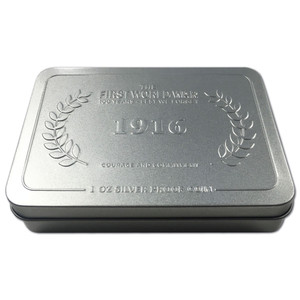By 1916 the scale of the Great War had been truly realised. Few New Zealanders had been left unscathed by the Gallipoli campaign, with fathers, brothers, friends and neighbours lost. At home, volunteers for service had slowed to a trickle and the first Anzac Day was observed a year after the Gallipoli landings. As the battle moved to the Western Front, where it would remain until 1918, the courage and commitment of the servicemen were sorely tested.
Issue information
With the increasing number of loved ones lost in service, by 1916 it must have felt as though there was no end in sight to the escalating conflict. The illusion of the ‘great adventure’ had been truly shattered and conscription was introduced on 1 August 1916 to counter the dwindling number of volunteers. The Post and Telegraph Department played a key role in delivering wartime communications, as well as being the bearer of sad news for many.
Abroad, the New Zealand Tunnelling Company (NZTC) made its mark in the Arras tunnels and the HMS New Zealand took part in the largest naval battle of the First World War, the Battle of Jutland. New Zealand troops continued to play a part in the Middle East and the New Zealand Expeditionary Force (NZEF) was part of one of the bloodiest battles in human history and New Zealand’s costliest campaign of the war - the Somme.
1916 Courage & Commitment is the third instalment in New Zealand Post’s five-year programme commemorating the First World War.
Against the backdrop of the Western Front, we tell the story of Cook Islander Solomon Isaacs. Solomon left behind his life in New Zealand and his family in the Cook Islands to serve in the First World War. He was just one of many Pacific Islanders to volunteer for service, and with the Pioneer Battalion he experienced the realities and difficulties of war first-hand.
First Day Cover
The ten stamps from this issue were available on a collectable first day cover, featuring a photograph taken from within the Arras tunnels.
Miniature Sheets
The two miniature sheets in this issue (one containing six 80c stamps and one containing two $2.00 stamps and two $2.50 stamps) featured a map of the Western Front as well as newspaper clippings from 1916. The four-stamp miniature sheet featured a newspaper report on the first Anzac Day while the six-stamp miniature sheet featured a newspaper clipping reporting on New Zealand’s involvement at the Somme.
Miniature Sheet First Day Covers
The two miniature sheets were incorporated in a set of two miniature sheet first day covers. The photographs on the covers complement the newspaper clippings, with the four-stamp miniature sheet first day cover featuring a photograph of the first Anzac Day in Dunedin and the six-stamp miniature sheet featuring a photograph of the New Zealand Medical Corps in Armentières, France.
Commemorative Book
The story of Solomon Isaacs’ and New Zealand’s role in the First World War throughout 1916 was told in greater detail in this unique commemorative book. The third in a series of five, this must-have collectable contained the story behind each stamp in this issue as well as further insights into New Zealand’s role in the war in 1916.
Within the pages of this commemorative book WAs the story of Solomon Isaacs, who left behind his life in New Zealand and his family in the Cook Islands to serve in the First World War in the 3rd Māori Reinforcements. Born in 1895 and raised in the village of Tautu on Aitutaki in the Cook Islands, Solomon signed up with the NZEF as a 19-year-old labourer living in Auckland. He served just shy of three years and returned to Auckland and eventually Tautu between 1920 and 1922.
As well as imagery of and insights into New Zealand’s war effort in 1916, this special collectable book contained 12 unique miniature sheets (not available individually).
The Solomon Isaacs Story
In 2016 we told the story of Cook Islander Solomon Isaacs, who showed incredible courage and commitment during his three years of service fighting for his adopted country and the British Empire.
Solomon Isaacs was raised in the village of Tautu on Aitutaki in the Cook Islands before moving to Auckland. Solomon worked in Northcote as a labourer and was just one of four Pacific Islanders who lived in New Zealand before volunteering. When war broke out, Solomon left New Zealand in February with the 3rd Māori Reinforcements, made up of Māori and Pacific Islanders.
Solomon had been in Egypt with the New Zealand Pioneer Battalion just two weeks when orders came in April to leave for the Western Front. Here, during difficult, dangerous labouring work, Solomon saw fellow Pioneers felled by artillery and sniper fire. When the Pioneers took part in raids, Solomon was armed with hand grenades as a company bomber. On top of the day-to-day hardships and danger, Solomon struggled with the stodgy rations and the terrible cold.
During his service, Solomon fell ill several times. After recovering from Trench Fever, he was temporarily attached to the New Zealand Tunneling Company. For nearly three months, Solomon helped dig an underground-cavern system underneath the town of Arras, pausing to carve his name and the date (24/2/17) onto a tunnel wall.
After armistice, he sailed for New Zealand, living in Grey Lynn, Auckland for several years before returning to Tautu. He married in August 1922.
When his son was one, Solomon went fishing alone in a remote lagoon for seafood that would fortify his wife’s breast milk. Sadly, Solomon stood on a stonefish and died shortly afterwards on 3 September 1923, aged 27.
Solomon is buried alongside his parents between family homes in Tautu. A concrete headstone bears his name, the words Great War Veteran, the New Zealand Expeditionary Force cross, and a silver fern.
You could learn more about Solomon Isaacs, his service and the story of New Zealand in 1916 with the commemorative book. We would like to thank Solomon Isaac’s family for allowing us to tell Solomon’s story in our five-year First World War programme.
Product Listing for 1916 Courage & Commitment
| Image | |||
|---|---|---|---|
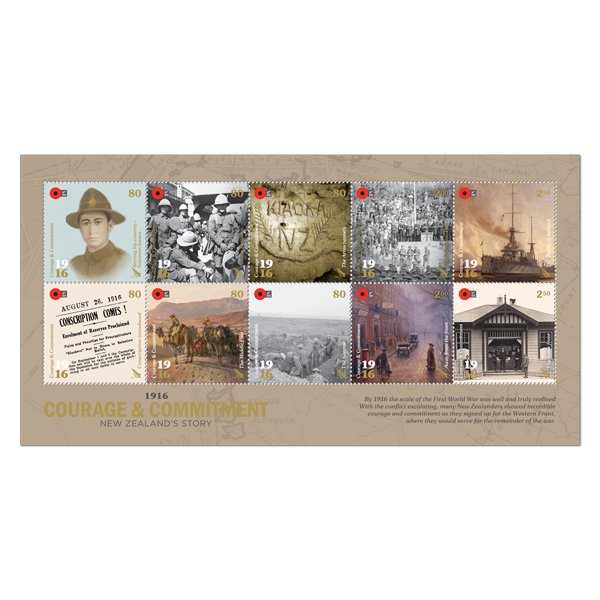 |
Mint, used or cancelled sheetlet of ten stamps. The individual stamps in this issue were: Single 80c 'Serving his country - Solomon Isaacs' gummed stamp. Solomon Isaacs served overseas for eight days short of three years as a member of the 3rd Māori Contingent, the Pioneer Battalion, the NZTC and the Rarotongan Company in Palestine, before returning to Auckland and eventually Tautu between 1920 and 1922. Single 80c 'The Pioneer Battalion' gummed stamp. In February 1916 the 3rd Māori Reinforcements left New Zealand for Suez, Egypt. By 1917 the New Zealand Pioneer Battalion had become popularly known as the Māori Pioneer Battalion, a name that would stick until their return to New Zealand in 1919. Single 80c 'The Arras tunnels' gummed stamp. The NZTC arrived in France on 10 March 1916 to help carry out the Empire’s war strategy underground. The NZTC made its mark in the tunnels, naming key locations after New Zealand towns and cities. These markings are still visible today. Single $2.00 'The first Anzac Day' gummed stamp. 25 April 1916 was New Zealand’s first Anzac Day, one year after the landings at Gallipoli. Local services like the one featured on this stamp on the church steps in Nelson were the first of many in the years to come. Single $2.50 'The Battle of Jutland' gummed stamp. On 31 May 1916, the Imperial German Navy’s High Seas Fleet met the Royal Navy’s Grand Fleet in a clash in the North Sea known as the Battle of Jutland. The Indefatigable-class HMS New Zealand was one of 151 British vessels involved. Single 80c 'Conscription' gummed stamp. Conscription arrived on 1 August 1916 when the Military Service Act became law. All able-bodied Pakeha men aged between 20 and 46 were required to register for military service by 15 September – coincidentally, the first day that New Zealanders would fight at the Somme. Single 80c 'The Middle East' gummed stamp. New Zealand troops continued to play an important role in the Middle East theatre throughout 1916 and beyond. In March the New Zealand Mounted Rifles joined the Egyptian Expeditionary Force, and in the next few months pushed back Ottoman forces from the Suez Canal. Single 80c 'The Somme' gummed stamp. In September 1916 the first major offensive involving the NZEF got under way near the River Somme in northern France. By the time New Zealand troops and artillery were withdrawn from the front line, more than half of the 15,000 NZEF troops involved had been killed or wounded. Single $2.00 'Away from the front' gummed stamp. Many New Zealanders serving on the Western Front were still able to satisfy their sense of adventure and explore European soil. The NZEF soon had a permanent presence in London; its Bloomsbury Square headquarters is shown on this stamp. Single $2.50 'The home front ' gummed stamp. As well as being the place to enrol for military service, the local post office delivered news of deaths and injuries to anxious families. The Kaikoura Post & Telegraph office was one of many in New Zealand that played a crucial role in meeting the communication needs of war time. |
$13.80 | |
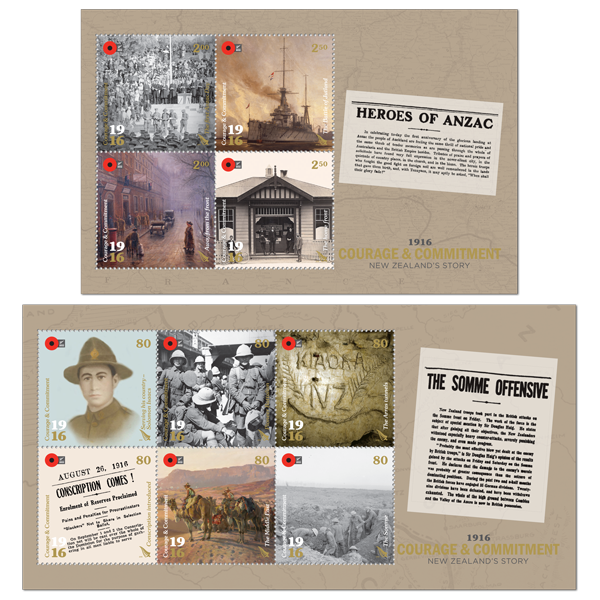 |
Set of Miniature Sheets |
Set of two mint, used or cancelled miniature sheets. |
$13.80 |
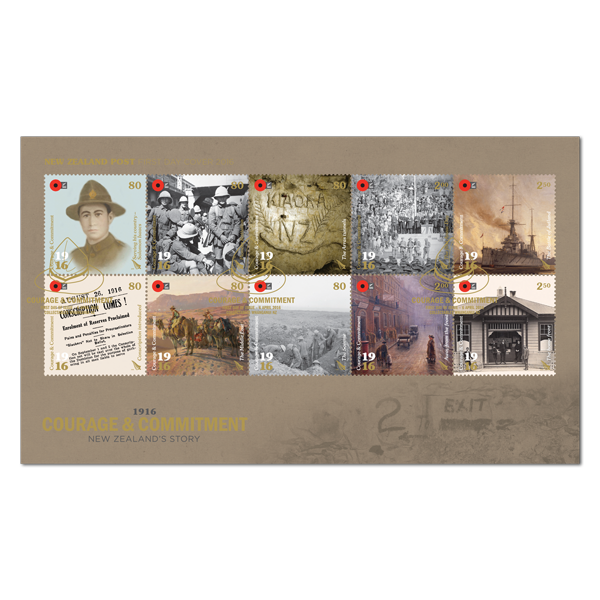 |
Sheetlet First Day Cover |
First day cover with stamp sheetlet affixed. |
$14.30 |
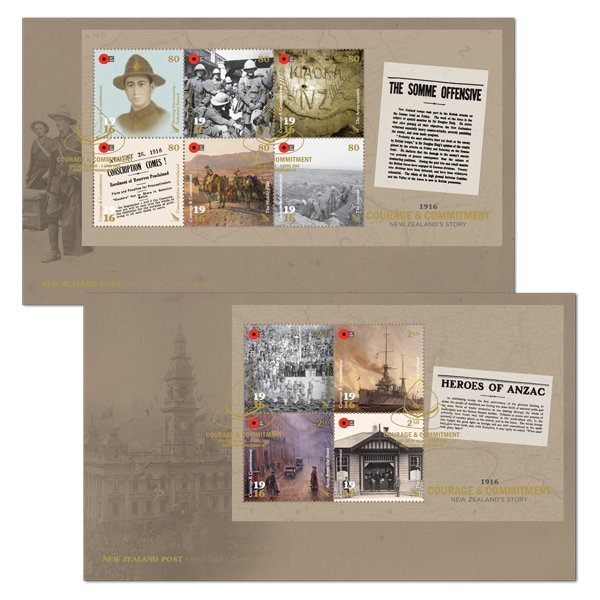 |
Set of Miniature Sheet First Day Covers |
Set of two first day covers with miniature sheets affixed. |
$14.80 |
| Miniature Sheet Booklet |
Within the pages of this commemorative book was the story of Solomon Isaacs, who left behind his life in New Zealand and his family in the Cook Islands to serve in the First World War in the 3rd Māori Reinforcements. Born in 1895 and raised in the village of Tautu on Aitutaki in the Cook Islands, Solomon signed up with the NZEF as a 19-year-old labourer living in Auckland. He served just shy of three years and returned to Auckland and eventually Tautu between 1920 and 1922. As well as imagery of and insights into New Zealand’s war effort in 1916, this special collectable book contained 12 unique miniature sheets (not available individually).
|
$39.90 |
Technical information
| Date of issue: | 6 April 2016 |
|---|---|
| Number of stamps: | 10 gummed stamps |
| Stamps and first day covers designed by: | Strategy Design and Advertising, Wellington, New Zealand |
| Denominations: | 6 x 80c, 2 x $2.00, 2 x $2.50 |
| Printer and process: | Southern Colour Print Ltd by offset lithography |
| Number of colours: | Four process colours |
| Stamp size and format: | 36.95mm x 37.5mm (horizontal) |
| Paper type: | Tullis Russell 104gsm red phosphor gummed stamp paper |
| Number of stamps per sheet: | 24 |
| Perforation gauge: | 14.4 x 14.62 |
| Period of sale: | These stamps remained on sale until 5 April 2017, First day covers remained on sale until 5 June 2016. |




